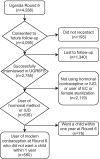Association between experience of specific side-effects and contraceptive switching and discontinuation in Uganda: results from a longitudinal study
- PMID: 34838097
- PMCID: PMC8627069
- DOI: 10.1186/s12978-021-01287-5
Association between experience of specific side-effects and contraceptive switching and discontinuation in Uganda: results from a longitudinal study
Abstract
Background: There is substantial evidence that contraceptive side-effects are a major deterrent to consistent use of contraception but few studies in low- or middle-income countries explore the role of specific side-effects on contraceptive use dynamics. This study used population-based, longitudinal data to explore the effect of specific side-effects on contraceptive continuation, discontinuation, and switching in Uganda.
Methods: Data for this study come from two rounds of survey data collection in Uganda: PMA2020's sixth cross-sectional survey and a follow-up survey conducted 1 year later. The main outcomes of interest were discontinuation and switching among users of hormonal contraceptive methods (implants, injectables and oral pill) and the IUD at baseline (n = 560). Multivariable logistic regressions assessed the association of experiencing specific side-effects (more bleeding, less bleeding, irregular bleeding, increased dryness/reduced libido, and physical discomfort) with discontinuation and switching 1 year later, adjusting for socio-demographic characteristics, type of method, and length of use. We also examined the differential effects of side-effects between discontinuation and switching risks.
Results: About 23% of hormonal and IUD contraceptive users reported experiencing side-effects at baseline survey. Overall, discontinuation and switching were higher among injectables and pill users, compared to IUD and implants users. Reporting more bleeding or less bleeding increased the odds of discontinuation and switching by 2.74 (95% CI 1.00-7.51) and 1.86 (1.04-3.34), respectively. There was no significant difference in discontinuation and switching by side-effects.
Conclusions: Greater attention should be paid to understanding the unique contributions of side-effects to contraceptive behavior using population-based data. While about a quarter of women reported experiencing side effects, those who experienced bleeding specific side effects were at higher risk of contraceptive discontinuation and switching. Providing greater individualized care that includes information and counseling about common side-effects, how they may impact daily life, and how tolerable these effects may be is necessary.
Keywords: Contraceptive continuation; Contraceptive side-effects; Contraceptive switching; Longitudinal; Menstrual bleeding; Sexual experience; Uganda.
Plain language summary
Research has shown that experiencing side-effects is related to stopping use of contraception, even when women wish to avoid pregnancy. Most research, however, does not differentiate between distinct side-effects, such as increased bleeding or changes to sexual experience, and instead combined all into “side-effects or health concerns”. We used data from 560 women in Uganda, who were interviewed twice, 1 year apart, to see if women who reported different side-effects at the first interview were more likely to stop using contraception or switch to a different contraceptive method than women who did not report experiencing side-effects. We found that increased or decreased menstrual bleeding was associated with a higher odds of contraceptive discontinuation and switching, Contraceptive discontinuation or switching was not different by women’s reporting of vaginal dryness/reduced libido or physical discomfort, such as cramping. It is important to understand what side-effects are likely to motivate stopping or switching contraception so that education and counseling can inform women of side-effects they may experience, help them choose the best method based on what side-effects they deem important, and if necessary, aid in switching contraceptive methods.
© 2021. The Author(s).
Conflict of interest statement
The authors declare that they have no competing interests.
Figures
References
-
- Castle S, Askew I. Contraceptive discontinuation: reasons, challenges, and solutions. Washington, DC: Population Council and FP2020; 2015. p. 41.
-
- Bradley SEK, Schwandt HM, Khan S. Levels, trends, and reasons for contraceptive discontinuation. Calverton: ICF Macro; 200AD. (DHS Analytical Studies). Report No.: 20. https://www.dhsprogram.com/pubs/pdf/AS20/AS20.pdf. Accessed 5 Mar 2021.
-
- Rosenberg MJ, Waugh MS. Oral contraceptive discontinuation: a prospective evaluation of frequency and reasons. Am J Obstet Gynecol. 1998;179(3 Pt 1):577–582. - PubMed
-
- Diamond-Smith N, Campbell M, Madan S. Misinformation and fear of side-effects of family planning. Cult Health Sex. 2012;14(4):421–433. - PubMed
MeSH terms
Substances
LinkOut - more resources
Full Text Sources


